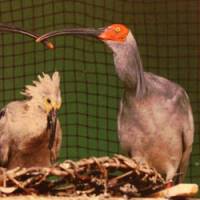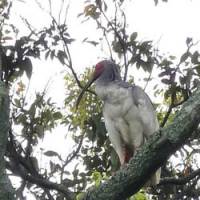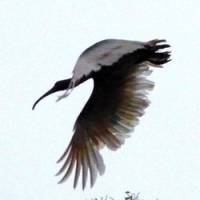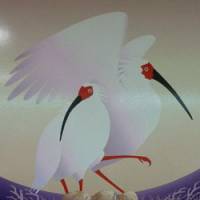High in the fork of a tall tree on a wooded slope close to narrow rice paddies on Sado Island in the Sea of Japan off Nigata Prefecture was a flimsy, ragged nest made of twigs.
It didn't look like anything special, but its significance far surpassed its physical appearance.
Alas, the miracle of life had not transpired there, but it still represented a huge step forward in the conservation of an endangered species.
That's because this was the very first nest built in the wild in Japan by a reintroduced crested ibis. Known scientifically as Nipponia nippon, and in Japanese as toki, no bird more clearly represents Japan, yet it was pushed into catastrophic decline — then allowed to slip toward extinction — before attempts were finally made to conserve it and help restore its numbers.
Not far from that epochal nest, at dawn on another day I heard a deep nasal, crowlike "taaa-taaa." The bird making that call was out of view, but because I reckon to know all the species occurring in Hokkaido, even though I had never heard its like before I instantly suspected that what I was hearing was a crested ibis — a bird I'd never heard or seen in the wild.
At 5:20 a.m., that rasping call had alerted me to a bird moving between treetops across the valley. Then I caught sight of it, recognizing at once the distinctive shape of an ibis with its giveaway long curved bill, gray foreparts, rosy-pink tinged wings and its short tail.
Sighting a "new" bird is usually an exciting moment, but this was more of an emotional one. During my very first visit to Japan back in 1980, members of the Yamashina Institute for Ornithology invited me to join them on a visit to Sado in preparation for their unenviable task of trying to capture the last handful of individuals surviving in Japan in the hope of breeding from them in captivity.
Once common and widespread in Japan, the crested ibis had been pushed into a catastrophic decline by a combination of pesticide pollution, hunting and habitat loss, then allowed to slip the final inches towards extinction; the rescue attempt ultimately to be made in 1981 seemed doomed to failure, and the thought of visiting an entire species on its metaphorical deathbed just seemed too morbid for me, and I declined the offer.
Nearly 30 years later, a near-miracle had been achieved thanks to a relic population of just four adults and three young birds discovered in 1981 in Shaanxi Province, in the mountainous area of Qinling in central China. Concerted conservation efforts in China have catapulted the population there from those seven to more than 600 in the wild and over 500 in captivity. They have, too, been the salvation of the Japanese population, as China has allowed the loan of birds to Japan to re-establish a breeding population here.
Internationally, Japan is better known for its anachronistic attachment to whaling than for its wildlife conservation successes. Yet success stories there have been, and Japan must be lauded for these and its ongoing attempts regarding numerous other species. For instance, conservation efforts have also allowed the Japanese crane to recover to more than 1,000 individuals, and work with the critically endangered Blakiston's fish owl is ongoing.
With help from China, Japan's efforts for the crested ibis have taken it from being extinct in the wild to now breeding regularly and successfully in captivity — and to being released once more into the wild.
Back in 1980, I had no expectation of this ever being achieved. Yet by 2008, the captive population at the specially built facility on Sado Island was considered healthy and numerous enough to begin the first releases. So, on Sept. 25, 2008, the first birds were given their freedom, allowing them once more to return to the forested hills and narrow valleys of Sado Island. More releases are planned for the years ahead.
In China, birds have been translocated successfully and are now breeding again in areas from which they had once been extirpated.
With all this in mind, when I heard the bird again twice that morning in May, then finally saw it at 6:10 a.m. foraging in some rice fields, imagine my euphoria at being able to watch it continuously until 7 o'clock. At 6:35 a.m. it was flushed from the fields by a farmer, but instead of flying away never to be seen again, it surprised me by flying over my head and landing in a tree behind me. I watched spellbound as it played with a dead leaf and called several times before flying off in the direction of that deeply symbolic nest.
The following morning, one of cool mist, found me back in the area listening to the extraordinary chorus of frogs mixed with the soft sound of oriental turtle doves cooing and the noisy rasping of brown-eared bulbuls. Soon after 5 a.m. I found the solitary bird foraging in the rice fields once more, and watched as it moved around its range calling. His calls seemed particularly poignant, knowing as I did that none of his species were within hearing range. Hence that ragged nest was emblematic of a hopeful return to the wild — but also of a certain futility.
In fact eight of the original 10 birds released on Sado Island in September were known to have survived their first winter, which bodes well for the future. Unfortunately, all four surviving females had moved across to the mainland of Honshu, leaving four males alone and frustrated on Sado. The futile nesting attempt was that of a solitary male. But as lonely as he may be, "Roku-chan" — so called because he has the number six (roku) on his leg band — had his mind on the right seasonal activity. Perhaps, with future releases to be considered annually, he may before too long be able to entice a female to his bachelor pad.
It is my hope that on future visits to Sado Island it will prove possible to watch more crested ibis in the wild there and, perhaps one day, to see the first pair to breed in Japan for more than 30 years.
In the meantime, anyone minded to visit Sado Island cannot fail to encounter untold images of toki — on tourist posters, dinner place mats and even immortalized in cartoon images carrying "Hello Kitty" on its back. But images are all the average visitor can see, unless they visit the Toki-no-mori Koen (The Japanese Crested Ibis Conservation Center) in Niibo. There, under rather poor viewing conditions, can be seen — at a distance and through curatins of wire mesh — several captive birds. As a conservation effort it's a great success, but as a viewing site it leaves much to be desired. Nevertheless I have visited three times in little over a year, each time becoming more critical of the public access, but more supportive of the conservation effort.
Mark Brazil is a naturalist and author who organizes and leads field excursions around Japan. His latest book is 2008's "Field Guide to the Birds of East Asia," and also still available is his earlier "A Birdwatcher's Guide to Japan." Copies are readily available through [email protected]






















With your current subscription plan you can comment on stories. However, before writing your first comment, please create a display name in the Profile section of your subscriber account page.